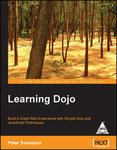Learning Dojo: Build A Great Web Experience With Simple Dojo And Javascript Techniques
"Dojo is a popular AJAX-specific open-source JavaScript framework for building powerful web applications. It provides a well conceived API and set of tools to assist you and fix the issues experienced in everyday web development. Your project size is no concern while using Dojo. It is the best scalable solution to all your size-related issues.
This book starts by giving you tips and tricks for programming with JavaScript. These tricks will help you with Dojo. With every chapter, you will learn advanced JavaScript techniques. You will learn to leverage Dojo for a clean web application architecture using JSON or XML.
What you will learn from this bookLearn tips and tricks in JavaScript that will help you get better at coding in Dojo
Explore Dijits (Dojo Widgets) with examples so that you can write your own Dijits
Serialize, automatically validate, and convert entered content with forms and layouts
Organize different kinds of data in the same Dijit using dojo.data for a better look and feel to your website
Animate your content using dojo.fx to give your pages a dynamic look and feel
Use closures and Dojo's Class-based OO system underlying all widgets and features
Use powerful formatting for Dates and Currencies between locales
Understand Dojo's event system, for classical browser events, function 'advice', and Dojo's publish/subscribe message bus
Learn to create dynamic Tree widgets using data sources, custom styling, and even drag and drop
Create custom widgets and reusable components that use all of Dojo's advanced layout managers and widgets
Learn to write custom PHP services to feed data to Dojo's client-side data- driven componentsChapter 1 Introduction to Dojo: This chapter gives an overview of the Dojo AJAX framework along with tips and tricks for using JavaScript and useful, generic Dojo functions.
Chapter 2 Useful JavaScript and Dojo Tricks explains Dojo's approach to object-oriented JavaScript programming.
Chapter 3 Basic Dijit knowledge: Dijits is Dojo's name for Widgets. A typical widget is a color-picker or a movable pane. This chapter introduces Dijits in general and gives a lot of examples on how to use them, how they interact, and even an introduction to writing your own.
Chapter 4 AJAX Communication: This Chapter covers AJAX communication in several aspects, with examples, which also show the view from the server (in PHP code).
Chapter 5 Forms: This Chapter covers form-related Dijits serializing forms and powerful validation and internationalization, best practices when setting up Dojo forms, and a run-down of available components.
Chapter 6 Layouts: The Layout Dijit organizes content, be it other Dijits or plain HTML. We will see a number of examples from simplifying layout in general with 'CSS-less' layout managers, to dynamic loading of content in content panes, and how to create a wizard widget with a Stackcontainer and a small amount of scripting.
Chapter 7 Data, Trees, and Grids: The datastores are perhaps the most complex area of Dojo, but also give the programmer an unprecedented level of modularity. In this chapter we go over a couple of simple examples, then describe the dojo.data interface, how to extend it, and how to use several different types of data in the same Dijit component.
Chapter 8 Effects and Animation: dojo.fx gives you a quick way to hide, show, or move something on the page. We have examples on animations and more advanced areas such as animating almost any DOM property over time and how to combine several animations in a chain. We also give examples on how to use the charting and drawing APIs before finishing of with a good dose of Drag and Drop: drag and drop nodetypes, and how to use draggable 'avatars' that change from drag to drop.
Chapter 9 Real-world Dojo: This chapter is almost entirely examples, focused on giving the reader full-blown guides to creating several types of applications with Dojo, and is also a store for cut-and-paste problem solving when time is of the essence.
Approach
The book is an example-based tutorial. Once the basics are done, it takes the reader through creating a number of examples, each focussed on a different interface task or visual effect.
Who this book is written for
This book is for web developers with JavaScript knowledge, who want to use Dojo for developing dynamic Web 2.0 applications.
Readers need basic web-page creation skills, HTML and CSS, and should be comfortable with the syntax of JavaScript."
This book starts by giving you tips and tricks for programming with JavaScript. These tricks will help you with Dojo. With every chapter, you will learn advanced JavaScript techniques. You will learn to leverage Dojo for a clean web application architecture using JSON or XML.
What you will learn from this bookLearn tips and tricks in JavaScript that will help you get better at coding in Dojo
Explore Dijits (Dojo Widgets) with examples so that you can write your own Dijits
Serialize, automatically validate, and convert entered content with forms and layouts
Organize different kinds of data in the same Dijit using dojo.data for a better look and feel to your website
Animate your content using dojo.fx to give your pages a dynamic look and feel
Use closures and Dojo's Class-based OO system underlying all widgets and features
Use powerful formatting for Dates and Currencies between locales
Understand Dojo's event system, for classical browser events, function 'advice', and Dojo's publish/subscribe message bus
Learn to create dynamic Tree widgets using data sources, custom styling, and even drag and drop
Create custom widgets and reusable components that use all of Dojo's advanced layout managers and widgets
Learn to write custom PHP services to feed data to Dojo's client-side data- driven componentsChapter 1 Introduction to Dojo: This chapter gives an overview of the Dojo AJAX framework along with tips and tricks for using JavaScript and useful, generic Dojo functions.
Chapter 2 Useful JavaScript and Dojo Tricks explains Dojo's approach to object-oriented JavaScript programming.
Chapter 3 Basic Dijit knowledge: Dijits is Dojo's name for Widgets. A typical widget is a color-picker or a movable pane. This chapter introduces Dijits in general and gives a lot of examples on how to use them, how they interact, and even an introduction to writing your own.
Chapter 4 AJAX Communication: This Chapter covers AJAX communication in several aspects, with examples, which also show the view from the server (in PHP code).
Chapter 5 Forms: This Chapter covers form-related Dijits serializing forms and powerful validation and internationalization, best practices when setting up Dojo forms, and a run-down of available components.
Chapter 6 Layouts: The Layout Dijit organizes content, be it other Dijits or plain HTML. We will see a number of examples from simplifying layout in general with 'CSS-less' layout managers, to dynamic loading of content in content panes, and how to create a wizard widget with a Stackcontainer and a small amount of scripting.
Chapter 7 Data, Trees, and Grids: The datastores are perhaps the most complex area of Dojo, but also give the programmer an unprecedented level of modularity. In this chapter we go over a couple of simple examples, then describe the dojo.data interface, how to extend it, and how to use several different types of data in the same Dijit component.
Chapter 8 Effects and Animation: dojo.fx gives you a quick way to hide, show, or move something on the page. We have examples on animations and more advanced areas such as animating almost any DOM property over time and how to combine several animations in a chain. We also give examples on how to use the charting and drawing APIs before finishing of with a good dose of Drag and Drop: drag and drop nodetypes, and how to use draggable 'avatars' that change from drag to drop.
Chapter 9 Real-world Dojo: This chapter is almost entirely examples, focused on giving the reader full-blown guides to creating several types of applications with Dojo, and is also a store for cut-and-paste problem solving when time is of the essence.
Approach
The book is an example-based tutorial. Once the basics are done, it takes the reader through creating a number of examples, each focussed on a different interface task or visual effect.
Who this book is written for
This book is for web developers with JavaScript knowledge, who want to use Dojo for developing dynamic Web 2.0 applications.
Readers need basic web-page creation skills, HTML and CSS, and should be comfortable with the syntax of JavaScript."
Top rated books in this category






























